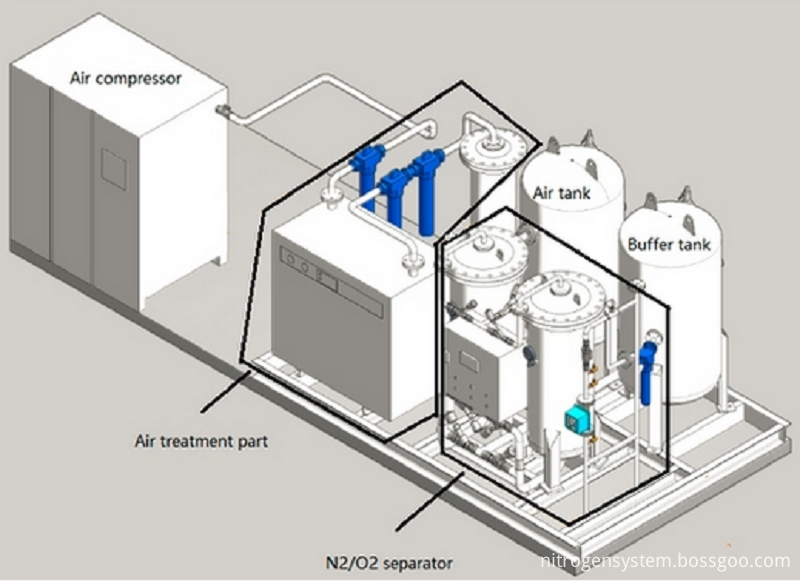Skid Nitrogen Generator is installed on one skid, it has compact structure, easy for ocean transportation, no need for site installation. When machine reach site, just need to put the machine on flat ground, connect power and gas pipeline, then one simple push on starting button makes the Nitrogen Generator begin to work. It normally includes Air Compressor, air tank, dryer and filters, also the key part, nitrogen separator. At the end of plant, there is one nitrogen buffer tank. This tank is also needed by the nitrogen generation process.
Standard Nitrogen Generator has skid structure, therefore they are also called skid nitrogen generator. Its basic specification is as below:
Flow rate: 5-3000 Nm3/hr
Purity: 90-99.9995%
Outlet pressure: 5-10 bars
Standard nitrogen generator structure:
Standard Nitrogen Generator,Nitrogen Generators,Nitrogen Generators System,Nitrogen Generation Equipment Shandong Gamma Gas Engineering Co. Ltd. , https://www.gammagases.com

Development trend of rare earth intermediate alloy industry
Middle rare earth alloy is one of the most important rare earth products, its use in steel is China's largest rare earth intermediate alloy applications. With the increasing demand for rare earth intermediate alloys in the iron and steel industry, the development of rare earth intermediate alloys with good quality and low quality is the future development trend of rare earth intermediate alloy industry.
(1) Select rare earth concentrate with high rare earth grade as raw material. China's rare earth intermediate alloy industry adopts the use of REO4%~6% large blast furnace slag to adopt REO10%~15% rich rare earth medium iron ore removal iron slag. Raw materials have greatly improved the technical and economic indicators of the alloy. The use of concentrate (REO 25%) is the only way for the metallurgical industry to improve economic efficiency. As soon as possible, China's major alloy production plants use high-grade rare earths. Mine is an effective measure to improve the competitiveness of China's rare earth intermediate alloy products in the international market.
(2) Choosing an economically rational metallurgical process The carbothermal method is the main process for the production of rare earth ferroalloys in the world. A large number of practices have proved that it is an economically rational process for large-scale production. China's carbon thermal method in the 1970s Production practices have failed due to the low grade of rare earth raw materials. After the advent of rare earth concentrates, this process should be re-evaluated through experiments to bring economic benefits to the rare earth intermediate alloy industry.
It is a good way to save energy by using slag into the furnace, or by rapidly reacting molten slag with liquid ferrosilicon in a shaker to smelt the alloy. The slag was introduced into the furnace as early as 1966. The test proved that the blast furnace slag can still maintain a certain fluidity after being injected into the electric furnace through a 11m long slag tank (5m of which is a water-cooled slag tank). Reductive refining can be carried out by electric heating or by directly adding ferrosilicon. In 1987, the slag was used to produce 30% of the alloy containing PE, which was 30% less than the cold slag, and the production efficiency was increased by 15% to 20%. The use of slag into the furnace requires careful selection of the slag furnace or the slag furnace. In the 1960s, it was suggested to use a full-water blast furnace to melt blocky cold slag. The thermal efficiency of the blast furnace is generally 60% to 70%, which is suitable for the treatment of bulk materials, and the melting capacity of the tuyere zone is 100-150 t/m 2 per day and night. It is advisable to use sulphur instead of electric energy to slag to most parts of China. In the late 1960s, tests were carried out on blast furnace slag, and an appropriate amount of limestone was added to the slag to make the slag into the electric furnace to make the alloy.
The idea of ​​rapidly reacting slag with liquid ferrosilicon in a shaker (or other suitable furnace) to smelt the alloy has not been tested and remains to be confirmed.
(3) The serialization of alloy products for the production of multi-standard and multi-form alloy products should include corresponding rare earth intermediate alloys for different application fields, different use conditions and different technical equipment. The chemical composition of the alloy should be adapted to local conditions. The dosage form should also be diversified. In recent years, due to the improvement of the Rare Earth National Importation Law, the supply of powder, core wire, briquetting and other forms has been put on the agenda. Domestically, there are also commodities listed on the market. These specifications should be gradually incorporated into the standards, so that production can be developed steadily.
The development of the rare earth intermediate alloy industry must rely on technological progress, and the investment in science and technology will eventually achieve huge economic benefits in production. Improving the process, reducing consumption, stabilizing quality, and developing new products that are marketable are the development direction of China's rare earth intermediate alloy industry.